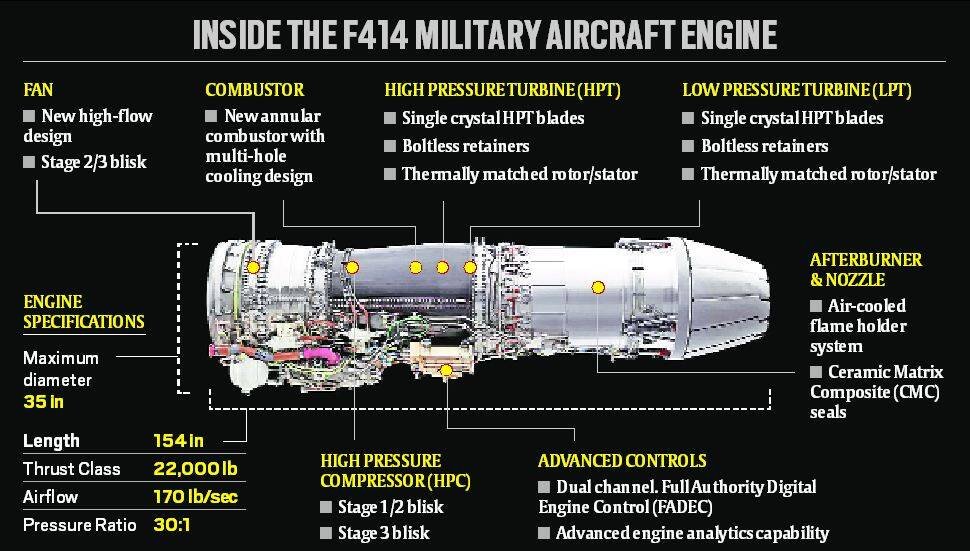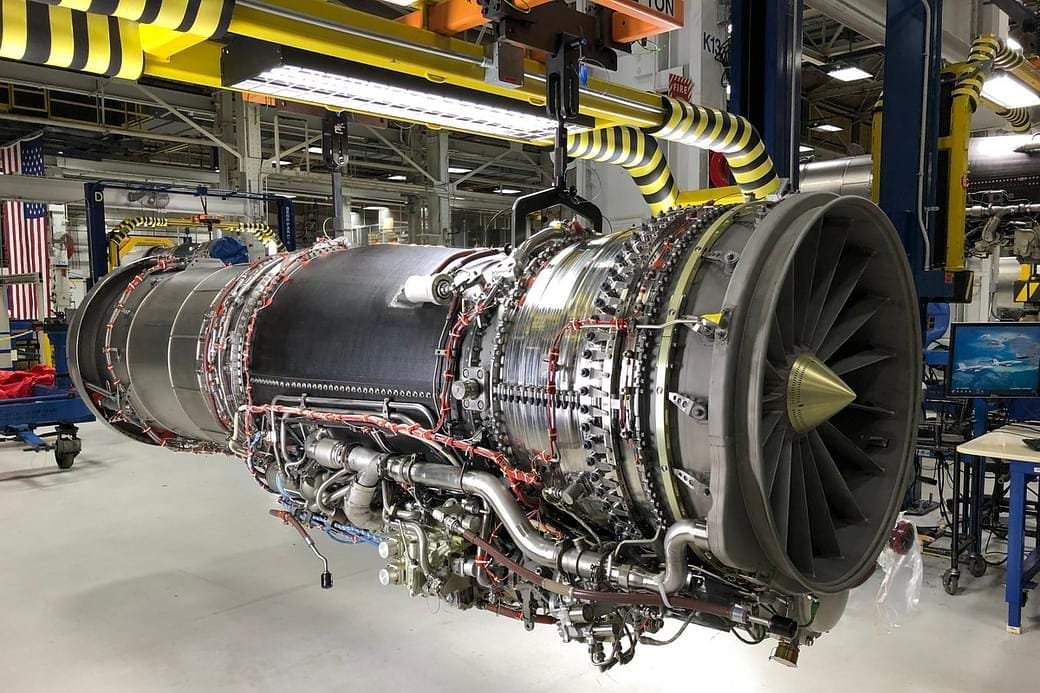Recently, India has announced a significant agreement signed between India And the USA in which India set to acquire Jet Engines Technologies Transfer. During India’s PM, Honorable Narendra Modi’s USA visit a most awaited and crucial agreement between American multinational Corporation General Electric (GE) and Hindustan Aeronautics Limited (HAL).
The agreement involves the technology transfer of Jet engines and the production of fighter jet Engines GE F414 indigenously which will be used in India’s fighter jet program for Light Combat Aircraft (LCA) Tejas MK2.
This agreement will significantly reduce India’s dependency on fighter jet engines in other countries, this will provide a huge boost to India’s fighter aircraft program and it is estimated to be completed by 2025.
What is General Electric (GE) F414?
GE F414 is an American afterburning turbofan jet engine produced by GE Aerospace, it is a highly efficient turbofan jet engine that is enlarged and improved for use in Boeing F/A-18 Super Hornet. It was first developed on May 20, 1993, and now it has approximately about 1600+ units GE F414 engine evolved from F404.

One of the major differences between F414 and F404 is fan section area, F414 has bigger fan section area which increases the airflow by 16% and produces an efficient thrust of 99KN.
| Specification | F414 | F404 |
| Thrust | 22,000lb | 17,800lb |
| Length | 154in | 159in |
| Diameter | 35in | 35in |
| Pressure Ratio | 30:1 | 27:1 |
| Weight | 2282lb | 1820lb |
Background on India’s defense needs and Collaboration with the USA
India’s defense needs and collaboration with the USA have evolved over the years with geopolitical developments, regional security challenges, and need for the India’s defense program. Here are some aspects of the background between India and the USA-
- India’s Defense Needs-
Regional Security– With the growing demand in the defense sector as India faces several threats and challenges in the Regional, geopolitical, and geographical areas including territorial disputes, cross-border terrorism, and nuclear proliferation, it seeks to maintain peace and harmony that can be only brought by making your country almost powerful and resilience. And with this motive and initiative, India set to acquire Jet Engines Technologies Transfer for making the GE F414 turbofan engine indigenously.
- Collaboration with USA–
From So long India and USA have collaborated in various regions and the USA has emerged as a major defense supplier for India in modern and present times. India has recently purchased C-130J Super Hercules transport aircraft, P-8I maritime surveillance aircraft, Apache and Chinook helicopters, and AH-64E Apache attack helicopters.
India is also involved in regular joint military exercises with the USA which take place once a year. Exercises like “Yudh Abhyas” and “Malabar” act like a reunion of Indian and US military personnel that has become a sign of Collaboration. Previously India and USA signed an agreement on the General Security of Military Information Agreement (GSOMIA), Logistics Exchange Memorandum of Agreement (LEMOA), and Communications Compatibility and Security Agreement (COMCASA)
Importance of Fighter Jet Engine Technology Transfer
For a Long time, India is struggling to produce indigenous fighter aircraft which is acting like a barrier for “Atmanirbhar Bharat”, and the major hindrance which is popping out is the inability to produce indigenous fighter aircraft jet engines. India has been working on its indigenous “Kaveri” Engine for a long time but fails to deliver the maximum and required output that is needed for Light Combat Aircraft (LCA) Tejas.
Advantage as India Set to Acquire Jet Engines Technologies Transfer
- Cost Reduction- Technology transfer can contribute to cost reduction in various ways like the use of indigenous production materials, engineers, and scientists, and most importantly it reduces high import duty taxes that are imposed. Furthermore, improved engine efficiency can result in fuel savings, lowering operational expenses for airlines and aircraft operators.
- Accelerated Development- Jet Engines Technologies Transfer can enhance the production rate and development of Fighter jet Engines as it does not impose any political restriction, or bilateral disagreement, and helps to establish research institutions that help in knowledge exchange within the industry can foster innovation and drive the advancement of jet engine technology.
- Global Collaboration- Jet Engines Technologies Transfer fosters collaboration between countries, companies, and institutions that helps in sharing collective resources. By sharing expertise and resources, stakeholders can work together to address common challenges and find solutions.
- Improved Performances- This aspect of the Technology transfer is so crucial because it helps to design the jet engines according to the Conditional and operational requirements of the defense program. Higher trust, better fuel efficiency, and emissions are the areas that can be focused on through technology transfer.
Potential Impact on India’s Defense Industry and Strategic Autonomy
- Reduction in Dependency– With the production of indigenous afterburners GE F414 turbofan Engines in India, India’s dependency on other countries will be reduced to a large extent. Technology transfer in this area would enhance India’s self-sufficiency in the defense sector.
- Economic Growth and Job Creation– Jet Engines Technologies Transfer and development of indigenous jet engines will help to stimulate India’s defense Industry and would create a link between facilities research and development centers. Technology transfer also creates jobs in the region and boosts economic growth.
- Strategic Autonomy–
The transfer of technology would enhance its strategic autonomy by reducing reliance on foreign suppliers, it would also provide a transformative impact on the aerospace and defense manufacturing industry. It also helps to take control over the defense capabilities, maintenance, production need, etc. As the Cost is reduced so it becomes easy to focus on other defense Armour and technologies.
Challenges and Future Prospects
- Intellectual Property Rights- Under the IPR many countries hesitate to share Jet Engines Technologies Transfer. Companies may hesitate to think of that, their technology may be misused or misinterpreted for a negative task. Balancing the need for protection with the goal of dissemination can be complex.
- Funding and Financial Constraints- Jet Engines Technologies Transfer requires appropriate funding and financial support for research, development, testing, and commercialization. Limited funding from the state can hinder the successful plan of technology transfer.
- Lack of Infrastructure and Resources– Technology transfer requires pre-developed and maintained Infrastructure and development resources and skilled personnel and framework. Developing countries or regions with limited resources may struggle to absorb and effectively utilize transferred technologies, hindering their successful implementation.
So this brings the end of the blog, We hope this blog has brought you to a meaningful conclusion about Jet Engines Technologies Transfer and it could make a significant impact on a country’s defense program and future aspects.
Thank You!!!
Which organizations or entities are involved in jet engine technology transfer from the USA to India?
USA’s General Electric (GE) and India’s Hindustan Aeronautics Limited (HAL)
Which Fighter Aircraft will use GE F414 Engines
Initially, it will be used in LCA Tejas MK-2
Which is better – F414 or F404?
F414 has a slight edge over F404 as it has bigger turbofan area which incres=ases the airflow through the fan and increases Thrust.





